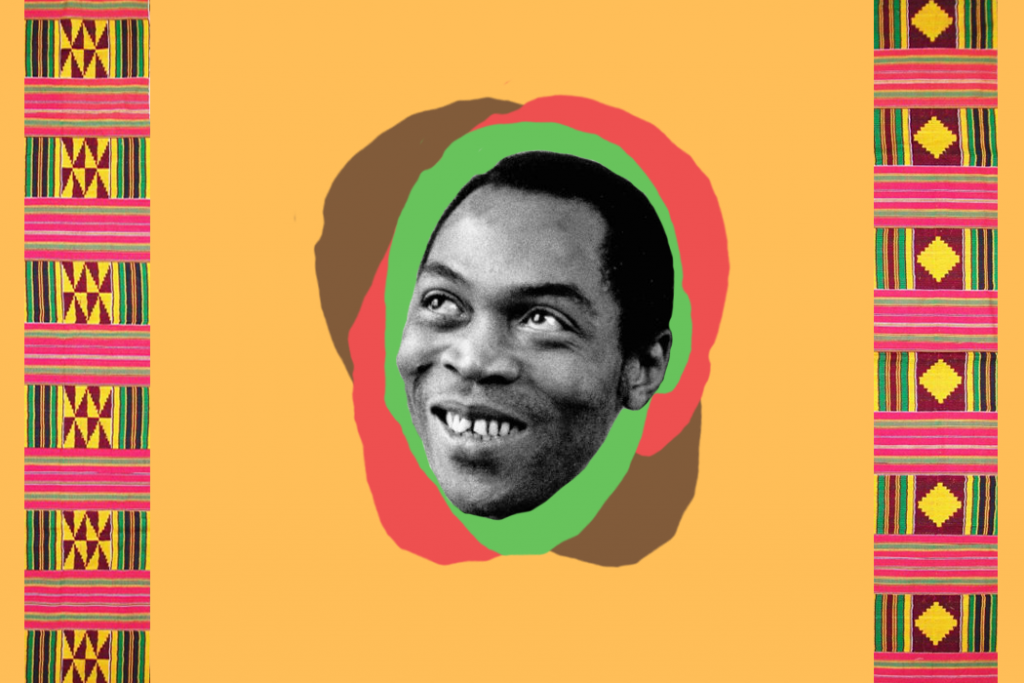+ Learn how to break out of repetitive loops and add emotionality and vulnerability to your tracks with Jlin in Rhythm, Variation, & Vulnerability.
Afrobeat is as eclectic as it is mesmerizing. Its roots stem from a few different areas geographically, socially, and musically. Genres such as jazz and funk, which were defined and carved out by black Americans who came of age during the Civil Rights Movement, helped contribute to its improvised foundation and its generally elastic nature. From Nigeria and Ghana, it took on the influence of West African folk rhythms and styles such as yoruba and highlife.
Yet, the genre’s sense of order and direction, especially in the large percussion, brass, and backing-vocal sections, has been handed down in various forms through the traditions of hundreds of African tribal avenues. When all of this is combined together, and set in the politically unstable context of a corrupt, oppressive government structure in Nigeria, afrobeat creates an aesthetic immediacy for the listener that grips him or her until the very end.
The groove tells us there’s a solid foundation, but the consistent interplay between improvisation and composition removes a vital, detectable center. Let’s look a bit closer at the factors that encourage this dichotomy, and why the end result feels so joyous!
If you get lost along the way, Soundfly created a course explaining the implied moods of harmonic theory in music, Unlocking the Emotional Power of Chords.
Harmonic Complexity in Afrobeat
So much of afrobeat harmony is implied rather than outright defined. It allows a certain kind of freedom for its performers. In most cases, you’ll find that the harmony remains simple, helping performers explore the Dorian scale of a specific minor key to their heart’s content, evoking more use of chromaticism during solos.
In contrast, the rhythmic ideas tend to vary much more, letting all of the percussive instruments dance around the static harmony with vigor and courage, any one of these rhythmic embellishments allowed the freedom to elevate to prominence at any moment. Since a lot of afrobeat’s definitive feel and identity comes from rhythm rather than the melody, the drums and percussion are often responsible for driving songs forward — a common tenet in funk’s musical structure.
Melodically, even in improvisation, the note choices tend to stay diatonic to the established minor key. The Dorian mode of the minor key reigns supreme, and that major sixth really gets put to work! You’ll be hard-pressed to find an afrobeat song that doesn’t end up using that scale degree at some point. Improvisation can find itself venturing into more avant-garde atonality at any point, but even then, it never feels departed from the intent of the song.
Because the harmonies tend to not change too frequently, and since the percussion is so multifaceted, I wanted to monitor the genre through the perspective of the instrument caught in the middle of it all: the bass.
Further down, we’re going to explore bass figures sandwiched between moving percussive and melodic ideas and what it takes for the bass keep it all together, while also effectively carving out its own space in the music. We’ll look at two of Fela Kuti‘s most well-known songs to help us figure this all out, as well as a song by an unlikely artist you probably didn’t expect to appear in this article!
+ Read more on Flypaper: “Rhythm Section Essentials Workshop: ‘Locking in’ with Bass and Drums”
Fela Kuti and Afrika 70 – “Zombie”
“Zombie” is the title track from his 1976 album that stirred up quite a controversy, using the word “zombie” to describe the regime of the Nigerian army at the time. Zombie was a smash hit, however, only adding to Nigeria’s frustration with Kuti’s criticism of his home country.
This first bass figure we’re going to look at will be accompanied by the guitar part. Both help lay down a solid foundation for any melodic ideas on top and lock in with the percussion without any problem at all.
The bass figure starts by outlining a G Minor chord, which it holds down for the rest of the tune. The guitar part, which actually finds its way to us before the bass drops, helps to give the bass a bit more life, cycling back and forth between G Minor (i-) and A Minor (ii-). This second chord emphasizes the prominence of the Dorian scale I mentioned earlier.
It’s a long song, and its mood never really deviates, so what makes it so irresistibly compelling?

For one, it’s masterfully arranged. Every now and then, the bass drops out, leaving only the guitar. And when it returns, it brings with it new instrumentation and new call-and-response passages to divert your attention away from the repetition of the groove. Call-and-response occurs in every section of the band, by the way, from the backing vocals to the percussion, the brass, and, of course, between the guitar and bass.
Fela Kuti and Afrika 70 – “Water Get No Enemy”
“Water Get No Enemy” appears on Kuti’s 1975 album Expensive Shit, a title which actually has a tidy, little story to it. Apparently, Kuti ran into trouble with the law for marijuana possession and found himself in a situation where he decided to ingest a joint the Nigerian police planted on him.
At that point, the police took him into custody and waited for him to pass the weed through his system. As the legend goes, the police were not happy with the outcome: Kuti somehow got ahold of another inmate’s bowel movement and was able to leave the jailhouse scot-free.
This song is another great example of how the bass outlines its progression rather than relying on another instrument to imply new harmony. Listen to how the bass sets up the progression using the downbeats of the bar. Given the way the percussive elements are organized around the bass specifically, everything falls into place via syncopation.
The intro features a descending bass line mixed with harmony from the keyboard to set the stage for what’s to come. This part plays less of a role in the grand scheme of things, and, once it’s over, we don’t actually encounter it again. I wouldn’t think of it as a throwaway section, rather, something to whet the listener’s appetite before the main course is served.
The chords in this section don’t necessarily receive their definition from the bass notes, but, instead, take a similar route to “Zombie” and end up creating harmony over an E♭ Minor environment.
E♭ Minor (three beats) / B♭ Minor (one beat) / G♭ Major (two beats) / F Minor (one beat) / D♭ Major (one beat)
Here’s what you’ll end up hearing for the remainder of the song, and it’s just a bit different from what we experienced with “Zombie.”
The bass sets up a ii-> v-> i- progression that doesn’t budge in the slightest for the rest of the song. It’s firmly established and only enhanced by the wavy keyboard that floats above. The chords are as follows:
F Minor (two beats) / B♭ Minor (two beats) / E♭ Minor (four beats)
As with “Zombie,” there’s a lot of thematic repetition to split up the sections. Unlike “Zombie,” though, it doesn’t break from the bass line, which gives the listener less of a sense that it is actually taking a break. In other words, as soon as the song gets going, you’ve pretty much experienced the entirety of the musical arrangement.
Beyoncé – “End of Time”
So, you’re probably wondering what a Beyoncé song is doing on a list describing afrobeat harmonic progressions. Let’s find out!
If you give the song a listen, you’ll find that it’s full of afrobeat influence — from the horn and drum-based instrumentation and periodic embellishments, to the call-and-response chorus, and even in Bey’s shouting-but-also-somehow-endlessly seductive vocal delivery. This isn’t really a full-fledged afrobeat composition, but the elements are certainly there, and they are very strong!
The second verse (1:58) and breakdown (2:30) introduce the most afrobeat-esque part of this song, the very part we’ll be looking at. The percussion is played with a march feel that’s present through most of the song, but, yet again, it’s the bass that drives everything home.
Again, pointing to the relationship between the harmony, melody, and rhythm, the sparse bass playing allows for Bey to weave her melody through E Major to E Minor in the breakdown: Can’t you see me / I just wanna love you / Can’t you feel me, babe / I just wanna be with you / I just wanna live for you / I’ll never let you go.
According to one of the producers of the song, The-Dream, drawing influence from Fela Kuti’s arrangement and inspiration was no accident. In the process of making her fourth album, they actually made an entire Kuti-inspired album! He states in an annotation for the lyric encyclopedia website, Genius:
“We did a whole Fela album that didn’t go up. It was right before we did 4. We did a whole different sounding thing, about 20 songs. She said she wanted to do something that sounds like Fela. That’s why there’s so much of that sound in the ‘End of Time.’”
This song paves the way for a great takeaway point. It’s quite easy to incorporate signature elements from afrobeat into your music, and I believe it’s important that we give this culturally distinct musical style every opportunity to continue to live in pop music today.
At first listen, afrobeat may seem restrictive or small in range. The depth of emotion and freedom expressible through its form, however, gave hope and newfound courage to many people, both during its inception and long after.
Keep on Grooving…
Continue your learning with hundreds of lessons on songwriting, mixing, recording and production, composing, beat making, and more on Soundfly, with artist-led courses by Kimbra, Com Truise, Jlin, Kiefer, RJD2, and our new The Pocket Queen: Moving at Your Own Tempo.





